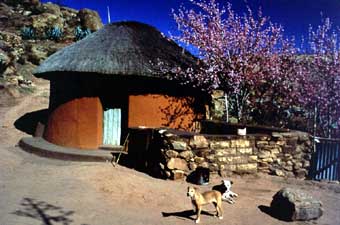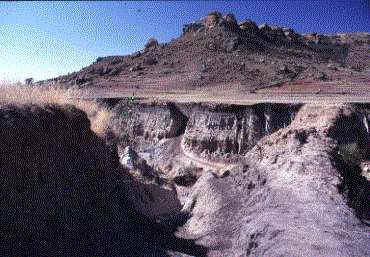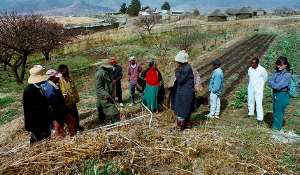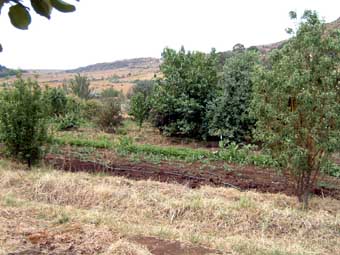
ACTION SPEAKS, PERMACULTURE IN LESOTHO By Joanne Tippett
This
article was first published in Permaculture
Magazine.
"Permaculture - the Magazine that's planting seeds..."
Ketso ea Bua (Action Speaks) is a community - based NGO (non-governmental organisation), founded in 1988 by Craig Anderson and the village of Ha Souru which is located in Lesotho. Ketso ea Bua aims to address problems of hunger and unemployment in the surrounding area through small-scale, self-help projects, which provide for basic needs and income generation. There is a core group of twelve members, with the active involvement of other villagers.
There was a general interest in permaculture in the village, as a member of Ketso ea Bua had attended a permaculture course several years ago. The group had heard of work we had done in the area, and were interested to know how permaculture could be applied to a vegetable growing project they were developing. Money was raised from the American Ambassador’s Self Help Fund, and we were hired to design and implement a permaculture plan.

A 3.5-acre site had been granted by the chief to Ketso ea Bua. The site
is bordered on two sides by severe erosion gullies and on one side by
a steep, rocky hill from which there is a high level of runoff during
rains. There are very few trees in the area (and none on the site), and
the landscape is dry and eroding. Adjoining land is used for cattle grazing
and maize growing. Five of the men went on an excursion in search of available
biomass, and returned with 5 sacks of leaves for mulch and 5 sacks of
cow manure. It had taken half of the day to find even this meager amount.
Fortunately, water was available on the site in the form of a reliable
spring.
A 2-metre high security fence, topped with barbed wire surrounds the plot of land. This is typical in Lesotho, where problems of theft of vegetables and fruit trees and uncontrolled grazing of green growth are rife. The image of this security fence surrounding a ploughed field of thistles and alfalfa is a stark one.
We had three main roles. The first was to find out the group’s goals, and to work out the best way of achieving them. As members of the group had not had much opportunity to see examples of sustainable agriculture, this included introducing them to alternatives in land use. The second role was to teach about permaculture principles underlying the design and the practical techniques that were being introduced. The third was to coordinate the implementation of the design. As we had little common language between us, communication took a variety of forms, which tested my acting ability and Buddy’s speed sketching skills.

During the previous two years, we had often worked with Ntate Maama Mosupha,
a farmer, teacher and village chief. One of the first things we did with
the Ketso members was to arrange a field trip to Ntate Maama’s orchard/garden,
so they could see first hand a local person applying permaculture successfully.
This was exciting for me, as I was able to listen to a former student
of mine explaining his application of permaculture principles. The field
trip was also attended by the Village and Ward Chiefs and five members
of the Village Development Council. This was important politically, as
they were also impressed and henceforth supportive of the project. In
the following weeks, Ntate Maama helped with Sesotho translation during
training sessions, and will be an important source of information and
assistance as the project develops.
The first week was spent in observation and asking questions about earlier projects and the group’s ideas for the future. We came up with some preliminary ideas, using the SuNstainable DesignWays process, which I developed and piloted while in Southern Africa. At this stage, we worked with members on a demonstration "Swale Orchard" (a swale is a water-harvesting ditch and bund on the contour of the land). This first swale was dug very slowly, possibly because members couldn’t initially see its value or role. After it had been planted with fruit trees, herbs, bushes and fodder grasses, however, there was a sudden comprehension and excitement. The remaining 450 metres of swales were dug phenomenally quickly.
As a result of the training sessions we ran, a similar leap of perception occurred about the role of trees on the land. There are few patterns of integrated agro-forestry in Lesotho. We discussed the role of trees in soil improvement and the water cycle, and introduced trees with a variety of products. Ketso members started to see that the trees could be a valuable and profitable part of a vegetable growing system. In the three weeks of implementation work, we planted over 500 trees. As well as providing fruit, nuts, forage for cattle, mulch, timber and firewood, these will act as a genetic bank for a future nursery. Another major shift in perception came with the understanding that animals can be an integral part of the agro-forestry system.

Two years of working in Southern Africa taught us a great deal about the
application of permaculture principles
to the process of participatory design, and how this leads to a greater
probability of a successful project.
One of the most important of these applied principles is the planning guideline of "build in feedback loops". We began the design process by asking questions and making demonstrations. The next stage was to complete the design with members, asking for reactions, further ideas and changes. This was done on the site, using rough sketches and physical descriptions. Initially, the process of doing demonstrations and having feedback sessions can seem to take a lot of time and slow down the process of design. We found, however, that the increased sense of ownership and understanding this process engendered was very important. The increased speed of implementation more than made up for the time and effort put into involving people in the beginning stages of the project.
This process of building in feedback loops was repeated as implementation proceeded, so that the final design reflected people’s growing understanding and input, as well as lessons learned during implementation. We were living in the village and also worked practically in the field. This helped to gain trust and respect early, which facilitated such a participatory design process.

Knowing we were soon to leave Southern Africa, we set up a system which
people could manage and develop without further input from us. It was
very important to come up with a clear plan, and to make sure we left
people with sufficient information to further develop the land. There
are few opportunities for Ketso Members to gain access to many of the
sources of information which we take for granted, such as books and educational
videos. One of the most important things we did, applying the ecological
principle of "connections", was to make contacts between people
working in the field of sustainable land use in the region. Especially
valuable links were those with other farmers, as farmer - to farmer exchange
of information is one of the most effective tools for learning and development.
Ntate Maama narrated the Sesotho version of the video we produced about
the permaculture plan and the uses of the plants on the site.
We instigated a novel experiment for land reclamation on the degraded hillside, currently used for communal grazing, which forms part of the Ketso project land. The typical model for re-afforesting hillsides is to erect a fence around the area, which is usually not popular with the owners of herds, and often leads to the fence being cut and the trees destroyed by illicit grazing. Pine and eucalyptus are usually planted, as they are not palatable to grazing animals. However, they do not supply "multiple uses" to the people in the area. We set up an experimental tyre/swale on the hillside, turning the "problem into the solution". These were rows of scrap tyres wired together, set on contour and weighed down with rocks. Multi-purpose trees and bushes were planted in every third tyre, and protected from grazing with high piles of scavenged thorny branches. Thus, many uses could be "stacked" onto the land, with managed grazing while growing trees for firewood, nuts, fruit and building materials, and bushes for berries and supplementary fodder for livestock, without purchasing expensive fencing. If this experiment is successful, clippings from the thorny hedge planted on the perimeter of the vegetable plot will provide resources for replication in the area. Provision was also made for growing cattle fodder as an integral part of water harvesting and soil stabilization within the vegetable plot, as cattle are symbolically very important in the culture of Lesotho.

One of the goals for this site is to develop a "land based training centre", which will eventually include a multi-purpose training, craft work and community building. On the last day we spent at the project, Ntate Seakanelo, the site manager, talked about one day standing on the patio of the centre, which will overlook the pond and agro-forestry system. At the time, all that could be seen were swales and tiny trees and herbs, but it made me realize that we had participated in a leap of perception of how much could be achieved using local resources and skills. For me, this leap of awareness was the most important and exciting part of what we accomplished while working with Ketso ea Bua.
Tsamea hantle, rea le boa. (Go well and thank you).